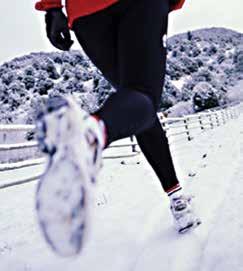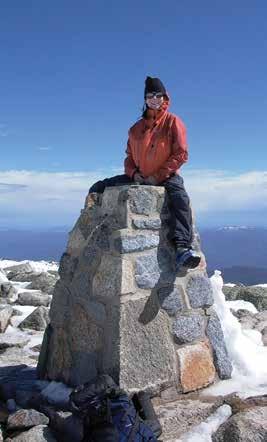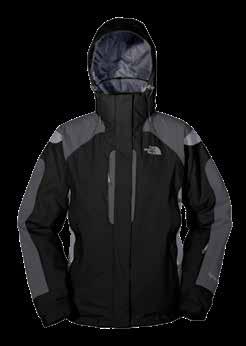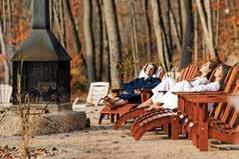
31 minute read
Cold weather running: Don’t let the winter slow you down
night I heard Nicholas screaming from somewhere in the pitch dark that he was locked in the outhouse. I was slow to rescue him because I was laughing so hard. Nicholas was unimpressed. Later, his time to laugh at me came when I found an ingenious way to heat up my sleeping bag. Turning a pot upside down on the wood stove, I placed the bag on top until it became toasty-warm. Unfortunately, it tipped off and onto the top of the stove. With a gaping burn hole in the cloth and the contents all over the floor, only duct tape saved the day.
On our last night in the cabin, we were greeted by four adults and six small children – a result of overbooking. The provincial park authorities provided us with a free snowmobile ride to another cabin, but we arrived in the cold dark with no paper to start the fire. We tried the small, damp guest book. No dice. What to do? We could choose from two alternatives: a book Nicholas had bought with his own money (but had already read), or my coffee filters. Nicholas ranted that it was a crime against humanity to burn books, but at -24 degrees F that thick, dry book seemed like the best choice. In my world, dark, freshly ground French roast coffee is a morning necessity. I won.
Advertisement
Actually, looking at the whole adventure, we both won. If you’re looking for a great winter get-away, try Le Massif.
GETTING THERE
CAR Highway 138 east from Quebec City for an hour to a well-marked Le Massif sign indicating a right turn. Follow the mountain road and you are there. FLY Daily, direct flights from Ottawa to Jean-Lesage International Airport at Quebec City. Rent a car, then follow the directions above. BUS Directly from Montreal to Le Massif with L’Express du Massif, 514-990-5914 ACCOMMODATIONS Provincial Park, Sentier des Caps de Charlevoix, 418-823-1117 or 1-866-823-1117 www.sentierdescaps.com Petite-Rivière-Saint-François is 10 minutes from Le Massif and has B&Bs. Baie-Saint-Paul is 20 minutes away with B&Bs, hotels and motels. Tourism Quebec’s guidebook lists accommodations and activities in the Charlevoix region, 877-266-5687. Le Massif 418-632-5205 or 877- LEMASSIF (yes, it has eight numbers) www.lemassif.com
Cold Weather Running
Don’t let the Ottawa winters slow you down
BY JOHN STANTON
IN THE CANADIAN High Arctic, instructors in a survival course tell air force pilots that there is one thing they must overcome to survive in a world where temperatures of –70ºC are not uncommon. It is the psychological fear of cold.
They also teach that the heart is an efficient heater and that pilots can function comfortably with a little help from proper clothing. Instructors note that in high mountain ranges, tiny organisms survive on rocks warmed by the sun while temperatures around them are well below zero. The organisms have their own microclimate.
We’re all somewhat larger organisms, but we too need to create a similar microclimate if we’re going to enjoy running in winter.
So many people ski and climb today that layering clothing is no secret. It’s just common sense. Wear polypropylene underwear next to your skin with a breathable outer, windproof suit made of a fabric such as Versatech, and you are in business. Another layer should be added IN BETWEEN THEM on very cold days. And there’s no doubt you’ll remember your mitts and tuque.
There’s a special joy in being the first footprints in the snow. The mental discipline that is often needed to get one foot out of the door when the snow is falling is exactly what comes in handy during the latter stages of a marathon. Get going!
SOME COLD WEATHER TIPS:
} Adjust the intensity of your workout. It doesn’t matter whether you cover the same distance you might on a summer day. You are out running. Decide on a time rather than the number of kilometres. } Warm up properly and start at a comfortable pace before easing up into a tempo that is slower than your normal training pace. } Shorten your stride to improve your footing on icy roads. Many runners insert a handful of small drywall screws on the outsides of their soles to give them greater traction. } Carry coins or a cellphone so you can get help in an emergency. Perhaps carry the cab fare home. } Run into the wind and coast home with it at your back. } Run with a group if possible. } If you are going out by yourself, tell someone your route and estimate how long you will be out. Find a route that allows you to cut your run short and get help if you need it. } Remember up to 50 per cent of the body’s heat is lost through the head. Wear a balaclava or tuque to keep you warm.
} In extreme temperatures, cover all exposed skin with clothing or petroleum jelly. If you are running with a partner, check each other’s face regularly for the white patches that mean frostbite. } Run facing the traffic and wear reflective gear. } Chapstick your lips, nose and ears. } Many a gentleman has found the hard way that it is best to protect future generations with a wind brief. } Keep your speed work for dry, indoor surfaces. } Seek a warm, dry place and medical attention if you suspect hypothermia. It’s caused by a drop in the body’s core temperature and it’s dangerous. Signs are incoherent, slurred speech, clumsy fingers and other signs of poor co-ordination. } We know of no runner who has frozen lungs in subzero weather, and we know some people who run outside when it is –40ºC. The air is warmed by the body before it enters the lungs. If you find breathing cold air uncomfortable, wear a face mask to help warm it. } Change into dry clothes as soon as you can after your run. ≈ John Stanton is the founder of the North American-wide Running Room and now new Walking Room stores.
The journey is the reward Mount Everest bid led Ottawa climber to her inner summit
BY SARAH MATTHEWS
Peggy Foster North Column Mount Everest June 2005 1

THREE HUNDRED METRES from the top of the world, Peggy Foster knew her energy reserves weren’t enough to get her down the mountain alive. At 45, Foster was attempting Mount Everest for the second time – the final peak in her odyssey to become the first Canadian woman to summit the highest mountain in each continent. Turning away from her goal brought her an enriched perspective on the whole of her life’s journey.
Foster’s decision to turn back was guided by her deep understanding of safety. “The theory is to have 25 per cent of your energy left when you are

on the summit so you can get down safely. Most climbers who die will die while descending Mount Everest, having calculated incorrectly the life force they have left to get down the mountain.”
Everest is the highest peak in the world at 8,848 metres, its summit separating Nepal and Tibet in the Himalayas. The sheer size, harsh climate and lack of oxygen makes Everest one of the greatest challenges to physical endurance and mental strength. The ascent which covers the north side, which Foster followed in her second attempt, is a harsher, longer, more technical and less travelled terrain than the south, which she had attempted in May 2003. But at 1,150 metres from her goal, she was forced to turn around because her Russian-made breathing apparatus failed to form a proper seal around her mouth, restricting the flow of oxygen into her body.
In order to summit Everest, climbers must spend months acclimatizing to its harsh environment. Foster had been on the mountain for her second try for more than two months before she reached Camp 4 at 8,300 metres – the final resting point before the summit. In this world, the wind can rip a tent to shreds, exposing climbers to a wind chill below –100°C. More than 120 bodies remain on the mountain, a reminder of its brutal force.
On June 4, 2005, at 11:30 p.m., a small trail of headlamp beams bobbed along the north side, upwards through a mix of rock and snow as Foster and her team of 20 climbers began their attempt over rocky, unstable ground. The climbers had to do basic rock climbing in the dark at altitude, with an oxygen mask and goggles strapped to their face while carrying a 16-kilogram pack.
That night, in what they call “the death zone” (everything above 7,500 metres), Foster made the decision to turn around. “The veil between life and death is so thin up there, the only thing you have to trust is your gut.” In her journal two days later she wrote, “I didn’t have the resources to descend safely from the summit – yes, a mere 300 metres from the highest peak in the world.”
Confident in her decision, Foster gave up her mountaineering goal and chose to “summit” her own life instead.
Born in Desbarats, a small town outside of Sault St. Marie, Foster spent much of her childhood playing in the woods with her three brothers and their friends. She moved to Ottawa at the age of eight when her father became a member of Parliament. Her parents encouraged an equality among their children that helped Foster overcome the intimidation of the world of extreme sports. Athletics was always central. “I started by doing triathlons and marathons in the ’80s, then went on to the iron man distance triathlons,” including the world championship in Hawaii. Next came ultra-running, a sport encompassing any race longer than the 26.2 miles that make up a marathon. Foster’s “grand-daddy” event in this sport was the Western States 100, a race that covers 160 kilometres over terrain with enough ups and downs to accumulate more than 12,000 metres of height. Foster placed second in her age category, and fifth overall.
Foster began climbing in the 1990s in the Canadian Rockies; it seemed a natural progression from ultra-running. Over the years she made it to the top of six mountains in the seven-summit odyssey – Aconcagua, Elbrus, Kilimanjaro, McKinley, Vinson and Kosciusko.
Like many athletes, Foster climbs mountains to escape the long reach of the contemporary world. “There are no cellphones, no Internet – just you, the mountain and your team.”
On her journey up Everest, Foster trod on some of the same paths as Sir Edmund Hillary and Tenzing Norgay, the first people to reach its summit. Hillary’s remark that, “It’s not the mountain we conquer, but ourselves,” matches Foster’s perspective. Despite turning back, Foster left with exactly what she needed. Her eyes laughed as she explained, “It sounds so lame to say that, but the jour
ney was truly the most extraordinary part of the experience.”
She recalled the expe- dition “as a microcosm of life, in which one experi- ences the extreme highs – joy, laughter, pure bliss – down to the plunging depths, sorrow, pain, lack of faith, and immobility.”
Foster left Everest feeling complete and linked to the rest of humanity. “People climb Everest every day of their lives, in relationships, in education, in terminal illnesses.” Such “mountains” aren’t defined by an isolated moment. “The summit doesn’t define who I am as a person,” but the journey can play a part.
Her attitude fits perfectly with her new role as head of outdoor education at Rosseau Lake College, a private school in the Muskoka lake country. Headmas- ter Joseph Seagram said, “What blew me away most about Foster, was how closely her persona reflects the school’s mission of challenging students to be best of self. There would only be a handful of people who could be rejected twice from a mountain and come away from the experience comfortable with the achievement.”
Although she left the mountain with- out the seven-summit title, her mission had evolved, and she came to realize that the summit “is secondary to what the experience itself offered me.” ≈ Sarah Matthews is an avid outdoor enthusiast who looks forward to her next adventure.
10
9
PHOTOS EXPLAINED 1 Climbing the lower part of the North Col of Everest – Tibet 2 North Col camp 1 – 7,000 metres, 22,400 ft. 3 Base camp North side of Everest – wearing my favourite expedition hat! 4 Visiting a school built and fully financially supported by
Himalayan Experience – our expedition leader; a mother and her son who have come to welcome us to their community school. 5 Denali (Mount McKinley) at a place called ‘The Edge of the Earth’ at 5,000 metres, 14,700 ft. 6 Sitting at the top of Australia! 7 Climbing the North Col of Everest – North side of Everest, Tibet. 8 Khumbu Icefall , South side of Everest crossing one of 66 ladders. 9 Climbing through the ice fog on Vinson Massif Antarctica – establishing a new route to the highest point of Antarctica. 10 Climbing from camp 2 on north side of Everest enroute to camp 3 @ 7,400 metres (23,680 ft.)
8




7


1. WHAT’S SO SMART ABOUT SMARTWOOL SOCKS?
Made of wool from New Zealand’s merino sheep, SmartWool fibres are longer and softer than other types of wool. So the socks itch less. SmartWool is different from ordinary wool because it has already been shrunk; it’s safe to put these socks in the dryer. Because merino sheep are exposed to extreme temperatures, their wool keeps you both warm in the winter and cool in the summer. How? By not holding on to moisture. Moisture-free socks and feet mean fewer blisters.
And then there’s smell.
Karen Fitzgibbons (Trailhead’s retail manager), says odour, or lack of it, is one of the reasons people choose SmartWool over synthetics. Although synthetic fabrics are lightweight and can wick moisture away from your skin, when they get wet and warm up they sometimes stink. And the wicking potential of synthetic fabrics in socks is limited because they just remove moisture from your feet and transfer it to your shoe lining, so that over time your feet may get wet and uncomfortable.
SmartWool traps moisture in hollow fibres full of microscopic air pockets. Your body heat turns it into vapour, which can evaporate, so both your feet and your shoe linings stay dry. The result is happy, comfortable feet all year round. Does this sound impressive? SmartWool socks have been so popular that the company now makes long underwear and winter accessories.
2. WHEN IS IT TIME TO CHANGE MY RUNNING SHOES?
Generally, quality running shoes will perform well for 500 to 800 kilometres, depending on your weight, heal strike and running surface. After taking you that distance, the shoe’s cushioning and stability starts to break down and your bones and joints begin taking the full shock of each step. It’s difficult to detect this deterioration visually since mesh uppers often look great long after the shoe is finished, so it’s a good idea to record the distance you’ve gone. One sign of wear includes less spring in your step. When you start experiencing sudden discomforts like knee pain, you’ve waited too long to retire old shoes.
Nicholas Eden-Walker of the Bank Street Running Room suggests trying on a new pair if you suspect your old runners are worn out. Then, if switching back to your old pair feels like sinking into the ground, it’s time for something new. Eden-Walker also notes that because running shoes are made with high-tech gels and cushioning, they have a shelf life of two years. After that, the gel and foam start to dry up and can’t compress and release at the same rate. So if you’re buying last year’s model at a discount, you may not be saving as much as you thought. A two-year-old pair of shoes, straight from the box, has 1/10th the kilometres in it that a brand new pair will provide.
Snow, rain, salt and slush corrode your shoes. So make sure you wipe the grime off after those harsh winter runs, and let your shoes dry out gradually. Putting them directly on a heating vent will fry their cushioning.
3. HOW DO I CLEAN MY SUNGLASSES WITHOUT RUINING THE PROTECTIVE COATING?
When you need quick solutions, Robin Glenney of Mountain Equipment Co-op’s optics department recommends microfibre glasses cases or microfibre Opti-Wipes. At $1.50 and $4 a pop, they won’t break your budget and won’t ruin your sunglasses. For a cleaner lens, use a specially formulated liquid cleaner which will remove oil as well as dirt. These cleaners are water-based, so if you need to use them in sub-zero temperatures, keep the glasses close to your body to warm them as much as possible.
At home, a rinse with Sunlight soap, gently applied with clean fingers and rinsed off in hot water, will give you a thorough clean. Whatever you do, resist the urge to give your sunglasses a quick polish with a tissue, a paper towel or the back of your T-shirt. You may not notice at first, but over time these occasionally put tiny scratches on the lenses. Over three or four years, this can lead to permanently smudgy sunglasses.
We deliver more than expected Great staff Great prices Great selection

WE CARRY THE FULL LINE OF



NORDIC PRODUCTS
Banshee Triclimate Jacket ™

Vortex Triclimate Jacket ™
Women’s

DON'T BE AFRAID TO MOVE MOUNTAINS , OR LET THEM MOVE YOU. Men’s
Great on the slopes or for your everyday winter pursuits, this versitale 3 in 1 jacket comes with a detacheable Heatseeker Triclimate ™ liner. The shell is fully seam sealed, waterproof and breatheable and features a Powder skirt to keep off nasty cold winds.
by The Expedition Shoppe

NOW OPEN IN OTTAWA!
All your North Face Products under one roof
342 Richmond Rd. Ottawa Tel: 728-6678
Eating away at your pain
BY DR. TODD NORTON AND NICOLA CAMERON
STIFF MUSCLES? MASSAGE therapy. Stiff joints? Pop a pill. Inflammation? Pop a different pill.
Many people treattheir injuries and illnesses as if they are caused by one element and treatable by another – usually some kind of drug. This kind of thinking doesn’t work when people face symptoms seemingly not caused by anything, or worse, caused by many interacting factors. “One-cause-one-effect” treatment fails.
Many health professionals, however, recognize how substances in our food and air can affect the “many-causesmany-effects” system that is the human body, creating inflammation that may lead to pain, stiffness and fatigue.
Acute inflammation is a bodily response to a sprain or strain, a cut or a burn. You get swelling, pain, redness and tenderness in the injured location. Chronic inflammation can involve a deeper metabolic shift in the body’s immune-messaging molecules, making the inflammation constant. That’s what happens in arthritis, atherosclerosis, diabetes, Alzheimer’s disease, fibromyalgia, Crohn’s disease and colitis.
But active people, world class athletes and recreational athletes often share this common thread of a physiology “tilted” towards chronic inflammation. They end up with prolonged pain and soreness after exercise, fatigue, poor recovery time, recurrent colds and flu, and an increased susceptibility to injuries. Natalie, for example, a 37-yearold competitive runner from Ottawa, enjoyed cycling, hiking, and other outdoor activities until recently. However, last spring she’d been getting more than her fair share of pain and stiffness in her muscles and joints. She wore out faster and stayed worn out longer than many of her training partners. “I was on the same training program as the rest in my group, but seemed to have a lot more pain and stiffness than anyone else. I became afraid of exercise.”
Then there’s Fred, an active 52-year-old who relished in-line skating, cross-country skiing, and mountain biking. Then he began, like Natalie, to notice unusual and frustrating pain and stiffness, sometimes lasting for days following exercise. He even hurt after doing simple tasks around the house. It perplexed him; his active friends weren’t hurting. “I thought age was just catching up to me at first and I should just slow down, but lots of friends who were older than I didn’t seem to have any problems.”
Fred and Natalie both instinctively examined only their activities to uncover a cause for their symptoms. Neither expanded their field of vision to include their entire physiology – and beyond that, their environment. Pain and stiffness can indeed be caused by physical activity, but they can be aggravated by a physiological disposition to inflammation.
Chronic inflammation can be triggered by workplace chemicals, air pollutants, pesticides, and heavy metals like lead and mercury, which can end up in our food. Then there’s the more “natural” allergens like poison ivy, pollens and moulds. For some people, what you eat is what can trigger inflammation leading to pain

and symptoms. Examples include some grains, peanuts, dairy products or yeast.
People with diabetes and blood sugar problems can have an inflammatory kickback, as can anyone suffering stress, or bad luck from their genetic heritage.
While environmental toxins and allergens you encounter while going to work and breathing are unavoidable, paying attention to your food is easy. If you are dealing with chronic lowgrade complaints, think about whether the foods you eat (coupled with the state of your digestive system) may be contributing to chronic inflammation. How this happens is not always obvious and is fairly common.
Here’s how it works with food. One of the largest barriers between external environmental threats and your body is across the lining of your intestines,
which contain more that 50 per cent of your body’s immune cells. Spread out your small intestine and you get a surface area as large as a tennis court – that’s a lot of room for trouble, as those immune cells confront certain proteins, chemicals and parasites in food. Chemical messenger molecules released from the gut can activate other immune cells in the liver, joints and other tissues, triggering inflammation at these sites.
The resulting grief can take many forms. In the gut, it can be excess bloating and gas; in the joints, pain and stiffness. It doesn’t stop there. Fatigue, headaches, more colds and flu, muscle aches, poor recovery after exercise, and susceptibility to recurrent injuries can be part of the picture, and people often accept them as “normal.” Unlike severe and often immediate anaphylactic-type reactions (think peanuts or bee stings), these gut reactions may be delayed for 24 to 36 hours. What you ate yesterday may be making you ache today.
That delay means it’s hard to figure out which foods might be putting you off stride. To figure out what’s doing
the hurting, foods can be systematically removed for a period of time, and then re-introduced to see if they cause the symptoms. A quicker approach is a food allergy test with a health professional to identify what’s eating you because of what you are eating.
If seeing a nutritional coach is not possible, here are some guidelines: } Avoid or minimize foods that tend to produce inflammation. They include processed foods; refined carbohydrates (like sugar and white flour products); poor quality oils (like cotton seed oil, peanut oil, margarine and shortening); cured meats; fast foods and other highfat or high-sugar foods; caffeine and alcohol. } Avoid known allergens like wheat, dairy, peanuts, citrus, corn, soy, etc. } Go organic and seek out those lean sources of protein, and oils from olives, fish, butter, flax, avocado, raw seeds and nuts. Eat slow-release carbohydrates like beans, peas, lentils, brown rice and millet; organic fruits, vegetables and fresh herbs; plain, naturally fermented yogurt, miso, and

sauerkraut. Other ways to ensure fitness include: } A good breakfast (whole grain cereals and breads, yogurt, nuts, eggs, and vegetables) sets the blood sugar tone for the day, lessens fatigue and flattens out those energy ups and downs. } Good timing. Eating meals on a regular schedule improves energy and blood sugar control, lowers bad cholesterol, and burns more energy. Eating next to nothing for breakfast and lunch, followed by gorging at dinner can wear you out and make you fat. } A balanced diet. Too many animal products slow down digestion and can lead to the toxin production that can trigger inflammation.
Chronic inflammation has many complicated causes, so if these self-help ideas don’t solve it, a naturopath or nutritionally oriented, regulated health professional can help identify the pain sources, and the best way to control them. ≈ Dr. Todd Norton, a chiropractor with an interest in clinical nutrition, has been practising in Ottawa for 12 years. You can contact him at 521-5355 or www.holisticclinic.ca.

Your direct access to a wide range of products and services that improve mental and physical well-being.




Showtimes Saturday 9 a.m. – 9 p.m. Sunday 9 a.m. – 4 p.m.
FREE ADMISSION
Exciting Prizes Family Fun Special Events
Informative Presentations

Featuring all aspects of healthy living in one venue:
FISCHER AMC 76 $899 (MSR $1199.00)
This All Mountain Cross wide carving ski for prepared slopes on- and off-piste action (50%/50%). With its innovative B-Magic design this 3D AirCarbon Titanium chassis will be an eye-catcher on any slope. The perfectly integrated Railflex2 ski plate binding system transfers energy instantaneously. The ideally matched MX7 boot makes this a serious contender in all situations.
LOOK FOR IT AT SHAVER SPORTS.
SALOMON EQUIPE SKATE SKI $499 (MSR $629.00)

This brand new ski sports some new features unique to Salomon. These include carbon fibre powered camber plate; new Ptex G5 Zeolit base; perfectly flat race tuned base; javelin skating sidecut; with a core of aerolite honeycomb. The cool thing is that the entire Subaru cross-country team switched exclusively to the Salomon ski and claim it’s the fastest ski they’ve used to date.
LOOK FOR IT AT FRESH AIR EXPERIENCE.

MEC NORTHERN LITE JACKET $110
The staff at MEC say this new jacket provides moderate warmth for any number of backcountry pursuits. With a wind, water, and tear resistant nylon shell and warm yet lightweight Primaloft insulation, it’s an excellent choice for threeseason use. It’s also roomy enough to wear over a sweater for extra warmth and the below-the-hip cut and close-fitting collar will keep out drafts, too. Other features include two hand-warmer pockets, a zippered inside pocket that doubles as a stuff sack for the jacket.
Available in both men’s and women’s styles.
LOOK FOR IT AT MOUNTAIN EQUIPMENT CO-OP

NORDIC SKATES $125
With a page from the Swedes, this latest outdoor invention allows you to skate like you’ve never done before. Just affix these blades to your nordic ski boots (binding required) and you get a skate that is more comfortable; has plenty of ankle support and interior padding; has curved tips (like skis) so they easily handle bumpy, rough, snow-covered ice better than others skates (canal, rivers) because the unique blade allows you to glide on top of the ice, instead of digging in like hockey skates and thus you can skate twice as far – or twice as fast – for the same amount of effort. Nordic Skates are suitable for ages 7 to 76. They’re for all the people who thought they’d never skate again because it wasn’t fun last time.
LOOK FOR THEM AT GREG CHRISTIE’S (IN CHELSEA)

BLUNDSTONE CHUNK 2 $180
Foot heaven. The new and radically comfortable Blundstone Chunk 2. More cushioned. More snug-fitting. For your first pair or your fifth, Chunk 2 is where you want your soles to go. Available in brown and black.
LOOK FOR IT AT GLEBE TROTTERS.

YAKIMA PLATINUM PRO 18 $824.99
As winter roles in and you need to transport your skis, snowboards etc...this is the perfect box for the widest range of vehicles. Some of the features include: no assembly with rapid-fire mounting hardwardware; dual-side opening for easy access; airalite material for strength; high-end spring-loaded lid supports help with one-handed access.
LOOK FOR IT AT TRAILHEAD.


NIKON D70S DSLR KIT $1449.95
It’s all about the memories, and what better way to capture them. If you’re going to treat yourself with one purchase this winter, this should be it. “The best gets better”, they say and the D70 starts faster, shoots faster, processes faster, buffers more images and displays faster than any comparable DSLR on the market today. Other features include: new larger LCD; better focus; new remote options; better menu display; larger eyecup; wider built-in flash coverage; and all part of this 6.1 effective mp, all with instant response times. Ho-ho-ho!
LOOK FOR IT AT GINN PHOTOGRAPHIC.

THE NORTH FACE PLASMA THERMAL JACKET $379.99
Great for skiing and urban life, this jacket has a waterproof, breathable, seam-sealed HyVent™ nylon faille weave with a 3-layer fabric shell. It also sports a nylon stretch oxford 3-layer HyVent™ Alpha fabric for the high abrasion areas. Additional features include: PrimaLoft® insulation for warmth without bulk; fully adjustable hood with wire-brim visor; two hand pockets, left Napoleon pocket and an internal security pocket. Close it all up with the Velcro® closure adjustable cuffs and hem, and you’re set for the Ottawa winters.
LOOK FOR IT AT THE EXPEDITION SHOPPE.
Winter Birding in Ottawa

BY TONY BECK
IN “THE WORLD’S coldest capital city,” wouldn’t you expect any selfrespecting wild creature to head south in winter? But natural habitats in Ottawa and Gatineau are very much alive during this harsh season. That’s when birders and naturalists from around the world come here searching for birds rarely seen south of the Canadian border.
Unlike most humans, some species adapt well to extreme conditions. As long as these creatures find lots to eat, they thrive, even in continuous –30°C temperatures (or colder) in the far north.
Most over-wintering birds prefer these conditions, being vulnerable to predators and lacking proper food sources in a gentler climate. The snowy owl for example, a formidable vole hunter, is perfectly camouflaged in a farm field blanketed in white. Pine grosbeaks – voracious fruit eaters – can clean a mountain ash of berries in a few days. Both species are northern nesters in summer, arriving here for winter, but rarely travelling any further south.
During some winters, northern birds invade the Ottawa area in large numbers. The winter of 2004-05 witnessed hundreds of great grey owls swooping across our local countryside searching for rodents. This kind of “eruption” occurs in cycles – typically when food sources dwindle up north. For the committed birdwatcher or anyone else, it’s an opportunity to experience some of nature’s most beautiful creatures.
Ottawa has extensive natural habitats, so all it takes is warm

clothes and good binoculars.
Although birds can show up almost anywhere at any time, here are a few of our most consistently rewarding sites for seeing birds – both common species and the rarities.
BRITANNIA CONSERVATION AREA AND DES CHÊNES RAPIDS
Potentially Ottawa’s best birding spot at any time, this west end site near the water filtration plant provides good views of the Des Chênes Rapids. The water stays largely ice-free despite the cold and attracts a variety of waterfowl and gulls. Activity usually increases at dusk when birds come to roost on the rapid’s exposed rocks. An extensive trail network through the scrub and forest of the conservation area can turn up a pileated woodpecker, or (with luck) a bald eagle overhead. In winter look for common goldeneye, mallard, great black-backed gull and herring gull. Among them you might find the more rare Barrow’s goldeneye, glaucous gull and Iceland gull.
OTTAWA AND RIDEAU RIVER RAPIDS (BATE ISLAND, REMIC RAPIDS, PARC BRÉBEUF, THE MILL IN MANOTICK, BILLINGS BRIDGE)
Similar to Des Chênes Rapids where the water is open all winter, excellent feeding draws in a variety of water birds. Among the plentiful mallards, black ducks and common goldeneye, look for the less frequent common merganser, hooded merganser, wood duck, and the occasional Cooper’s hawk or peregrine falcon.
NCC GREENBELT TRAIL NETWORK (JACK PINE TRAIL, STONY SWAMP, MER BLEUE, SHIRLEY’S BAY, GREEN’S CREEK, PINE GROVE)
Ottawa’s woodlands are teeming with the ever-present black-capped chickadees. These tame little gems are easily lured to sunflower seeds in your hand. It’s almost impossible to miss them along Greenbelt trails, where feeding stations make it easy to view chickadees and other birds as they fuel up. Among them are white- and redbreasted nuthatches, blue jays, downy and hairy woodpeckers, American tree sparrows and dark-eyed juncos. Some winters are brightened by the colours of evening grosbeaks, purple finches or bohemian waxwings. If you’re really lucky, you might happen upon a sawwhet, barred or boreal owl hiding in the thick cover of a conifer.
CENTRAL EXPERIMENTAL FARM (ARBORETUM AND FLETCHER WILDLIFE GARDEN)
Ottawa has an urban oasis attracting a multitude of winter visitors. The Arboretum, with its conifers, fruiting
trees and bird feeders, is a haven for finches and sparrows. The adjacent Fletcher Wildlife Garden, complete with bird feeder, is totally wildlife friendly. The surrounding open fields provide a clear range for winged hunters like peregrine falcon and Cooper’s hawk. Patient, keen-eyed birders check this area for rarities “to die for” like the gyrfalcon, down here from its eastern Arctic range.
FARM FIELDS (OUTER EXPERIMENTAL FARM, EAGLESON ROAD, FRANK KENNY ROAD)
Every winter, hawks and owls arrive to hunt voles, shrews, mice and other small animals, mainly over farm fields. Snowy owl, rough-legged hawk and red-tailed hawk are typically found in the farmland just outside the city. Some of winter’s most exciting birds (like great gray owl, northern hawk owl, goshawk or gyrfalcon) can be found by criss-crossing country back roads. And keep an eye out for the more common snow buntings, horned larks and gray partridge.
GATINEAU HILLS (STEELE LINE, EARDLEY, PALTIMORE, GATINEAU PARK, ETC.)
Many northern birds, especially finches and woodpeckers, find the Gatineau Hills perfect for winter feeding. Birds like white-winged crossbill, pine grosbeak, evening grosbeak, black-backed and pileated woodpecker enjoy the seeds from mixed conifer and deciduous woodlands. The Gatineau also attracts bald and golden eagles, especially along the edge of the escarpment.
Ottawa is a winter birder’s paradise. Don’t miss the action. For directions and more information check out these websites: } Neily World: http://ca.geocities.com/larry. neily@rogers.com/birding.htm } Ottawa Field Naturalists Club: www.ofnc.ca } NCC: www.canadascapital.gc.ca } Tony Beck: www3.sympatico.ca/beck.tony



Enjoy Gift certificates available a unique relaxation experience in the heart of nature! You deserve it! Scandinavian baths $35 | Scandinavian baths + massage $90
Open all year round, 7 days a week, from 10 am to 10 pm. Massages from 9:15 am.



Only 10 minutes from downtown Ottawa at the edge of the Gatineau Park.
16 Nordik Road Old Chelsea | Québec
(819) 827.1111 1 866 575.3700
www.lenordik.com
OUTDOOR HOT TUB > FINNISH SAUNA > STEAM BATH > COLD AND TEMPERATE BATHS NORDIC WATERFALL > SWEDISH, CALIFORNIAN, THAI AND HOT STONE MASSAGE THERAPY





